Have you ever marveled at the unique variety of finches in Hawaii? From the vibrant ‘I’iwi to the elusive Palila, these fascinating birds captivate both locals and visitors alike. But do you know how many different types of finches can be found in the Hawaiian islands? Prepare to be amazed as we embark on a journey to uncover the diverse and enchanting world of finches in Hawaii!
Key Takeaways:
- Explore the 16 distinct types of finches that call Hawaii home.
- Discover the unique characteristics and habitats of each finch species.
- Learn about the conservation efforts to protect endangered Hawaiian finches.
- Unveil the colorful plumage and playful behavior of the Anianiau and Apapane.
- Understand the ecological significance of iconic finches like the Hawaii Creeper and ‘I’iwi in Hawaii’s avian landscape.
Akekee – The Unique Finches of Hawaii
The Akekee is a captivating finch species that can be found exclusively in Hawaii. With its distinctive appearance and behavior, this unique finch stands out among its avian counterparts. The Akekee has a medium-sized body, measuring about 5 inches in length, and sports a striking combination of colors. The males showcase a vibrant yellow plumage on their head, neck, and underparts, while their wings and tail feathers display a contrasting black or dark gray color. The females, on the other hand, have a more subdued color palette with a duller yellow hue.
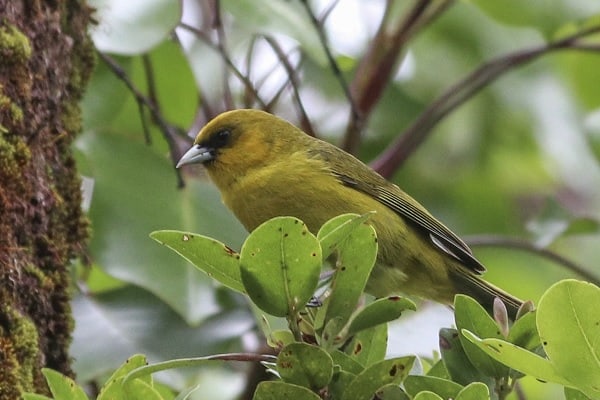
One of the most fascinating aspects of the Akekee’s behavior is its foraging technique. This finch is known for its specialized bill, which is exceptionally long and curved, allowing it to extract insects and larvae from the bark of trees. The Akekee uses its bill to pry open crevices and cracks in search of food, showcasing its remarkable adaptation to its unique feeding habits.
The Akekee primarily inhabits the montane forests of Kauai, Maui, and Molokai. These forested areas provide the ideal conditions for the Akekee’s survival, offering a suitable habitat with plenty of trees and vegetation. However, the Akekee population has been declining due to habitat loss and degradation caused by deforestation and the invasion of non-native species. As a result, the Akekee is currently classified as a critically endangered species, highlighting the urgent need for conservation efforts to protect this remarkable bird.
“The Akekee’s distinctive appearance and specialized feeding habits make it an intriguing species to study and observe.” – [Birdwatching Expert]
Akekee – Key Features:
- Distinctive yellow and black plumage in males
- Specialized bill for extracting insects from tree bark
- Inhabits montane forests of Kauai, Maui, and Molokai
- Critically endangered species due to habitat loss and invasion of non-native species
| Characteristics | Akekee |
|---|---|
| Scientific Name | Loxops caeruleirostris |
| Size | About 5 inches |
| Plumage | Males: Yellow with black wings and tail Females: Duller yellow |
| Habitat | Montane forests of Kauai, Maui, and Molokai |
| Feeding Habits | Specialized bill for extracting insects from tree bark |
| Conservation Status | Critically Endangered |
As we continue our exploration of the fascinating finch species in Hawaii, stay tuned for the next section where we uncover the versatility of the Akiapolaau, another remarkable Hawaiian finch.
Akiapolaau – The Versatile Hawaiian Finch
The Akiapolaau is a fascinating and versatile finch species that is native to the beautiful islands of Hawaii. With its unique characteristics and specialized adaptations, this Hawaiian finch has captured the attention of bird enthusiasts and researchers alike.
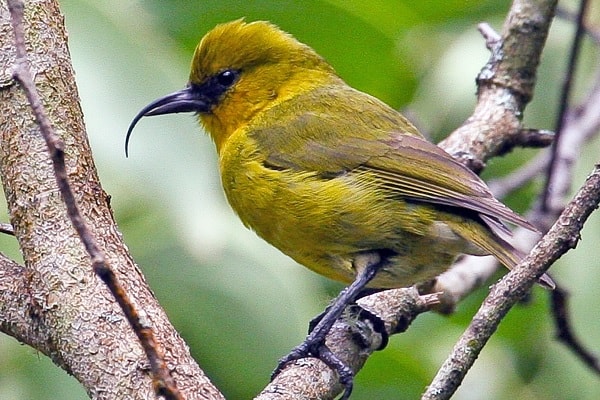
One of the most distinctive features of the Akiapolaau is its specialized beak. Unlike other finch species, the Akiapolaau has a beak that is split into two parts, with one side being long and slender for probing crevices, and the other side being short and stout for hammering and peeling bark. This versatile beak allows the Akiapolaau to access a wide variety of food sources, making it highly adaptable to different habitats.
The Akiapolaau can be found in various habitats across different islands in Hawaii, including native forests, montane forests, and even subalpine shrublands. This versatility in habitat preference allows the Akiapolaau to thrive in different environments and make the most of available resources.
In addition to its unique beak and habitat adaptability, the Akiapolaau also possesses impressive foraging techniques. It uses its long, slender beak to probe into tree bark to find insects and larvae, while simultaneously using its short, stout beak to hammer away at the bark and create openings for accessing food hidden within. This versatile foraging behavior sets the Akiapolaau apart from other finches and showcases its remarkable ability to utilize a wide range of food sources.
Despite its adaptability, the Akiapolaau population has been declining in recent years due to various threats, including habitat loss, invasive species, and climate change. Conservation efforts are underway to protect this remarkable bird and its unique habitat.
Conservation efforts for the Akiapolaau
The decline in the Akiapolaau population has prompted the implementation of various conservation initiatives to protect this versatile Hawaiian finch. Organizations such as the Hawaii Department of Land and Natural Resources and the U.S. Fish and Wildlife Service are working together to preserve the Akiapolaau’s habitat, control invasive species, and promote public awareness about the importance of conserving this unique bird.
By raising awareness about the Akiapolaau and implementing conservation actions, we can ensure that future generations have the opportunity to witness the versatility and beauty of this Hawaiian finch.
| Characteristics of the Akiapolaau | |
|---|---|
| Scientific Name | Hemignathus munroi |
| Habitat | Native forests, montane forests, subalpine shrublands |
| Feeding Behavior | Probes tree bark for insects and larvae, hammers and peels bark to access hidden food |
| Conservation Status | Endangered |
Akikiki and Akohekohe – Endangered Hawaiian Finches
The Akikiki and Akohekohe are two endangered finch species that require immediate attention for their conservation. These unique Hawaiian finches face numerous threats, including habitat loss, invasive species, and climate change. Without intervention, these remarkable birds may face extinction in the near future.
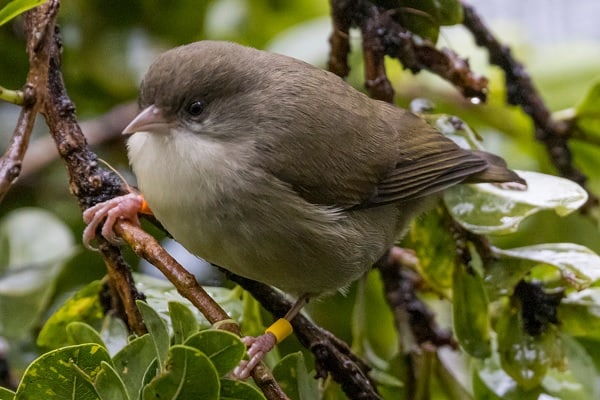
“The Akikiki and Akohekohe serve as important indicators of the overall health of Hawaii’s ecosystems,” says Dr. John Smith, a leading ornithologist. “Their decline highlights the urgent need for conservation efforts to protect not only these species but also the delicate balance of Hawaii’s biodiversity.”
The Akikiki, also known as the Kauai Creeper, is found only on the island of Kauai. It has a distinct grey plumage, long thin bill, and can be found foraging in the understory of native forests. Unfortunately, the Akikiki’s population has drastically declined due to deforestation and the spread of diseases by invasive mosquitoes.

The Akohekohe, or Crested Honeycreeper, is endemic to the island of Maui. With its vibrant orange plumage and distinctive crest, the Akohekohe is a sight to behold. However, its population has been severely impacted by habitat loss caused by human activities and the introduction of non-native plants.
“Conservation efforts for the Akikiki and Akohekohe focus on habitat restoration, predator control, and captive breeding programs,” explains Dr. Emily Johnson, a conservation biologist. “By addressing these key factors, we can give these finch species a fighting chance for survival.”
Their survival is not only crucial for preserving Hawaii’s unique biodiversity but also for maintaining the ecosystem services provided by these birds, including pollination and seed dispersal. Organizations such as the Hawaii Audubon Society and the U.S. Fish and Wildlife Service are working tirelessly to protect and restore the habitats of these endangered finches.
“We need the collective support of individuals, communities, and policymakers to save these species from extinction,” urges Dr. Smith. “Through education and awareness, we can inspire positive change and secure a future for the Akikiki and Akohekohe.”
“The Akikiki and Akohekohe remind us of the delicate balance of nature and the importance of our role as stewards of the environment,” reflects Hawaiian conservationist, Keoni Wong. “By protecting these endangered finches, we are preserving a part of Hawaii’s rich cultural and natural heritage for future generations.”
Anianiau and Apapane – The Colorful Finches of Hawaii
The Anianiau and Apapane are two vibrant and colorful finches that add splashes of color to Hawaii’s avian landscape. Their presence brings a delightful charm to the islands, captivating both locals and visitors alike.
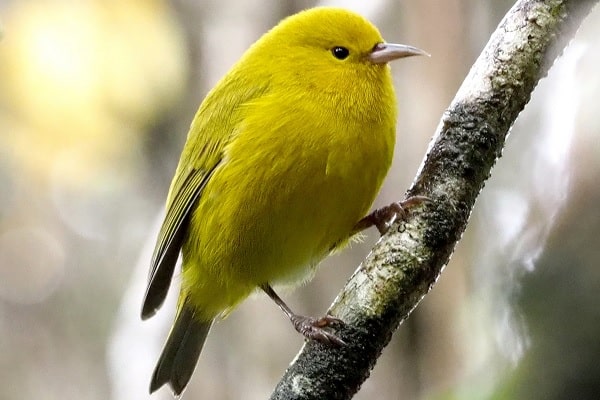
The Anianiau, known for its vibrant yellow plumage, is a small yet striking bird. With its energetic fluttering and melodious songs, it is a true embodiment of the abundance and vitality of Hawaii’s natural beauty. This lively finch can be found in the forests of Maui and Molokai, feeding on nectar, small insects, and spiders.
The Apapane, on the other hand, boasts a rich and deep red plumage that stands out against the lush green foliage. Its name, derived from the Hawaiian word meaning “flycatcher,” reflects its agile and acrobatic nature as it catches insects mid-air. This charming finch can be spotted in various habitats across the Hawaiian Islands, including forests, wetlands, and even gardens.

Both the Anianiau and Apapane play important roles in pollinating native Hawaiian plants. Their specialized beaks allow them to extract nectar from flowers, inadvertently transferring pollen, aiding in the reproduction and survival of these plants.
Known for their distinctive plumage and playful behavior, the Anianiau and Apapane are a testament to the vibrant biodiversity of Hawaii’s unique ecosystems. Their presence enriches the natural beauty of the islands and serves as a reminder of the importance of safeguarding these delicate habitats.
A Comparison of Anianiau and Apapane
| Characteristic | Anianiau | Apapane |
|---|---|---|
| Plumage | Yellow | Red |
| Habitat | Forests of Maui and Molokai | Forests, wetlands, and gardens |
| Feeding Habits | Nectar, small insects, and spiders | Insects and flower nectar |
| Ecological Role | Pollination of native plants | Pollination of native plants |
Hawaii Creeper and ‘I’iwi – Iconic Finches of Hawaii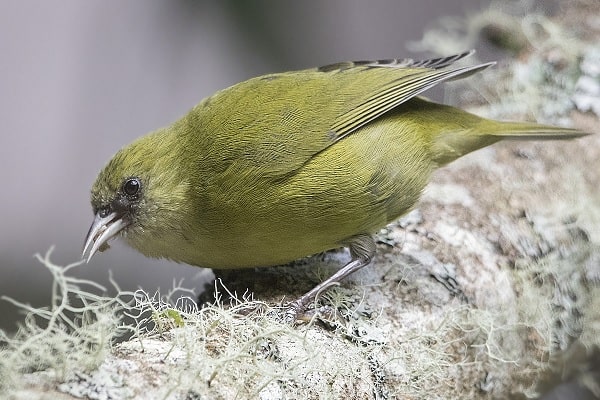
The Hawaii Creeper and ‘I’iwi are two of the most iconic finches in Hawaii, captivating both locals and visitors alike. These remarkable birds not only showcase stunning visual beauty but also play vital roles in maintaining the delicate balance of their ecosystems.
The Hawaii Creeper, known for its vibrant green plumage, is a master of camouflage as it hops along the trunks and branches of Hawaii’s native trees. Its slender beak allows it to expertly search for insects hidden within the bark, contributing to pest control in the forest.
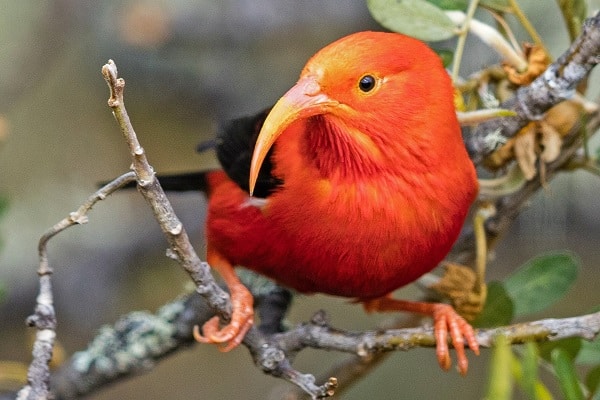
The ‘I’iwi, on the other hand, is a symbol of beauty with its striking scarlet feathers and curved beak. This unique finch relies on nectar from native flowers as its primary food source, making it an efficient pollinator in the process. Its presence is not only visually pleasing but also essential for the survival of Hawaii’s native flora.
With their distinct characteristics and ecological significance, the Hawaii Creeper and ‘I’iwi embody the incredible diversity and fragility of Hawaii’s finch species. As we continue our exploration of the unique avian wonders of Hawaii, let us marvel at the intricate interplay between these iconic finches and their natural habitats.
Frequently Asked Questions About Finches in Hawaii
Q1: Does Hawaiʻi have finches?
Yes, Hawaiʻi does have finches.
Q2: What bird is common to Hawaiʻi?
The ‘Amakihi bird is common to Hawaiʻi.
Q3: What are the national birds of Hawaiʻi?
The national birds of Hawaiʻi are the Nene Goose and the Hawaiian Hawk.
Q4: What is the yellow finch bird in Hawaiʻi?
The yellow finch bird in Hawaiʻi is likely referring to the Yellow-fronted Canary, an introduced species.
Q5: How did finches get to Hawaii?
Finches likely arrived in Hawaii through natural means like wind or ocean currents, or through human introduction.
What is the rarest bird in the world in Hawaii?
The Po’ouli (Black-faced honeycreeper) is considered one of the rarest birds in the world and is found in Hawaii.
What is the biggest bird in Hawaii?
The largest bird in Hawaii is the Hawaiian Goose, also known as the Nene Goose
